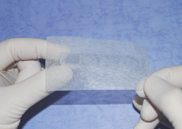|
BBO Crystal Handling
BBO has a low susceptibility to moisture. The
AR coating or the protective coating ( P-coating ) on the crystal faces can
protect the faces from moisture to some extent. It is fine to leave the
crystal in the setup for most optics labs with HR =< 40%. However,
we suggest to store the crystal in a desiccator if it will not be used for
over > 1 month to prolong the crystal lifetime. Alternatively, a small
enclosure (with openings for light) may be built around the crystal with dry
nitrogen or air continuously flow into the enclosure. The dry nitrogen/air pressure needs
only to be slightly above the atmosphere to keep the small volume around the
crystal dry and clean.
BBO is relatively soft and therefore requires precautions to protect the
surfaces.
Cleaning the Crystals
Dust and stains on crystal surfaces can cause
scattering/loss of light and can even react with light to damage optical
surfaces at a high incident laser power.
You can inspect the crystal surface for dust
and stains by holding it near a bright visible-light source. Viewing at
different angles helps to see scattering from dust and stains. The crystal
surface has to be cleaned if dust and stains are found.
You should perform the following cleaning
procedures in a clean, low-dust environment while wearing powder-free gloves
or finger cots.
1. Blowing off the crystal surface
A canister of compressed N2/clean air or a blower bulb
(http://www.adorama.com/GTRABS.html ) should be first used to blow off dust
and other loose contaminants. If a dry nitrogen line is available in the
lab, an air gun can also be used to blow away dust particles. Blow off the
surface gently. Do not blow off the crystal itself from your hand !
2. Drop and Drag Method
Hold the crystal so that the c rystal
surface is horizontal and slightly above your fingers. Take a fresh, clean
sheet of lens tissue and place it on the crystal. Make sure the lens tissue
can be drawn across the crystal surface. Next place a small drop of pure
isopropyl alcohol (IPA) on the lens tissue on top of the crystal surface. The weight of the
solvent will cause the lens tissue to come into contact with the crystal
surface. Slowly but steadily drag the damp lens tissue across the crystal
surface being careful not to lift the lens tissue off of the surface.
Continue dragging the lens tissue until it is off of the surface. rystal
surface is horizontal and slightly above your fingers. Take a fresh, clean
sheet of lens tissue and place it on the crystal. Make sure the lens tissue
can be drawn across the crystal surface. Next place a small drop of pure
isopropyl alcohol (IPA) on the lens tissue on top of the crystal surface. The weight of the
solvent will cause the lens tissue to come into contact with the crystal
surface. Slowly but steadily drag the damp lens tissue across the crystal
surface being careful not to lift the lens tissue off of the surface.
Continue dragging the lens tissue until it is off of the surface.
The amount of the solvent can be adjusted for
various crystal size so the lens tissue is kept damp for the entire drag but
there is not any visible trace of solvent on the crystal surface after the
drag is finished. Inspect the surface and repeat if necessary, but only use
each sheet of lens tissue once.
If the crystal surfaces are still “dirty”
after the above cleaning procedures, the surfaces might have been damaged.
Please contact us for rework of the
crystals.
|